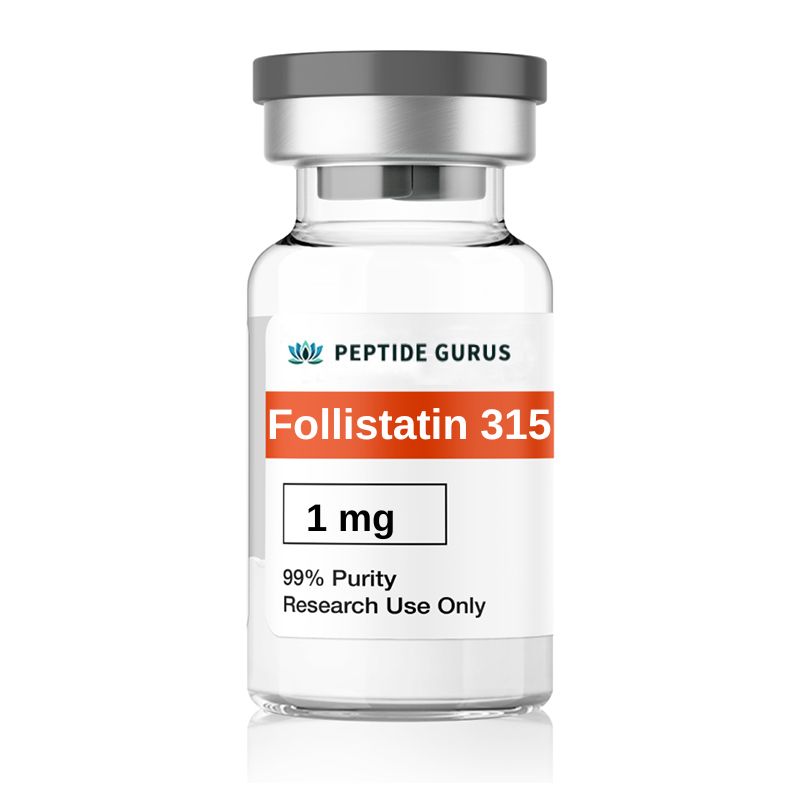



Categories: Peptides and Their Dosages
Follistatin 315 1mg, provided with Bacteriostatic Water, is available with free shipping on orders over $500 USD, excluding capsule products, cosmetic peptides, promo codes, and shipping. This promotion enhances accessibility to Follistatin-315, a predominant variant of a glycoprotein found in blood plasma, known for its binding properties with activin and myostatin, leading to improved muscle growth (hypertrophy and hyperplasia), reduced inflammatory responses, and enhanced fertility.
Product Usage: Follistatin 315 is strictly sold for research purposes. It is intended for in vitro testing and laboratory experiments only. Information presented is for educational purposes and the introduction of this compound into humans or animals, as well as any misbranding or misuse as a drug, food, or cosmetic, is prohibited by law. Only licensed, qualified professionals should handle this product.
What Is Follistatin 315?
Follistatin 315, an isoform of the follistatin protein family, neutralizes activin’s diverse effects across different tissues, from promoting to inhibiting cell proliferation. Beyond deactivating activin, it also binds myostatin in muscle tissue, significantly enhancing muscle cell growth and proliferation. This protein is also instrumental in developmental processes of embryos and plays a crucial role in regulating fertility.
Follistatin 315 Structure
The structure presented here pertains to the unaltered full-sized follistatin protein, critical for understanding its complex functionality.
Sequence: G NCWLRQAKNG RCQVLYKTEL SKEECCSTGR LSTSWTEEDV NDNTLFKWMI FNGGAPNCIP CKETCENVDC GPGKKCRMNK KNKPRCVCAP DCSNITWKGP VCGLDGKTYR NECALLKARC KEQPELEVQY QGRCKKTCRD VFCPGSSTCV VDQTNNAYCV TCNRICPEPA SSEQYLCGND GVTYSSACHL RKATCLLGRS IGLAYEGKCI KAKSCEDIQC TGGKKCLWDF KVGRGRCSLC DELCPDSKSD EPVCASDNAT YASECAMKEA ACSSGVLLEV KHSGSCNSIS EDTEEEEEDE DQDYSFPISS ILEW
Molecular Weight: 3470 g/mol
PubChem CID: 178101631
Synonyms: Activin-Binding Protein, FSH-Suppressing Protein, FST, FST-315
Follistatin 315 Research
While the entirety of follistatin’s effects remains under investigation, initial research identifies its origin from ovarian follicular fluid, acting primarily as an inhibitor of follicle-stimulating hormone. Various isoforms such as follistatin 315, 300, or 288 arise from a 344-amino-acid precursor, each residing in distinct tissues, revealing the protein’s broad physiological impacts.
The disruption of the follistatin gene in mice is lethal due to crucial roles in lung development and various other physiological and structural functions. Studies utilizing human follistatin 315 indicate its involvement in multiple vital processes, including blood vessel formation, muscle growth, inflammation regulation, and heart function.
Muscle Function and More
Initial studies on follistatin 315 created ‘mighty mice’ with quadruple the muscle mass of typical mice by manipulating myostatin and follistatin levels. This research suggests multiple muscle growth mechanisms, one clearly being myostatin inhibition, with another yet undefined pathway potentially stimulating nerve connections to muscles, enhancing both muscle tone and mass.
Inflammatory Role
Follistatin’s role extends to managing inflammation across various conditions. For instance, in rheumatoid arthritis models, it counteracts worsening conditions by regulating activin A levels. Its potential in treating inflammatory pulmonary diseases and its implications in fibrosis also highlight its therapeutic possibilities.
Vascular and Kidney Functions
Follistatin also aids in vascular health, enhancing endothelial function, particularly post-injury, which could be crucial in stroke and heart attack treatments. Its promising effects in kidney disease models demonstrate potential benefits in managing chronic conditions by mitigating inflammation and promoting healthy blood vessel function.
Disease Marker Potential
Elevated follistatin levels in cardiovascular diseases suggest its utility as an early marker for disease progression, providing a potential tool for early intervention and better management of conditions like heart failure.
Protein Engineering
Advancements in protein engineering, using follistatin as a model, are leading to more effective and predictable modifications to enhance therapeutic efficacy, showcasing the protein’s foundational role in biomedical research.
Follistatin 315, while only for in-vitro research and not for human consumption, presents a fascinating area of study with potential impacts across various fields of medicine and therapy, continually revealing its multifaceted roles in human biology.
PeptideGurus is a leading supplier of American-made research peptides, offering top-quality products at competitive prices. With a focus on excellence and customer service, they ensure a secure and convenient ordering process with global shipping.
CONTACT